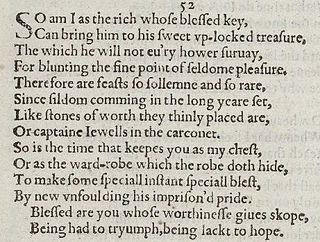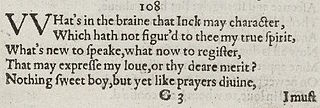In poetry, a hendecasyllable is a line of eleven syllables. The term "hendecasyllabic" is used to refer to two different poetic meters, the older of which is quantitative and used chiefly in classical poetry and the newer of which is accentual and used in medieval and modern poetry.
In poetry, metre (British) or meter is the basic rhythmic structure of a verse or lines in verse. Many traditional verse forms prescribe a specific verse metre, or a certain set of metres alternating in a particular order. The study and the actual use of metres and forms of versification are both known as prosody.
A rhyme is a repetition of similar sounds in the final stressed syllables of two or more words. Most often, this kind of "perfect" rhyming is consciously used for effect in the final positions of lines of poems and songs. Less strictly speaking, a rhyme may also variously refer to other types of similar sounds near the ends of two or more words. Furthermore, the word rhyme has come to be sometimes used as a shorthand term for any brief poem, such as a rhyming couplet or nursery rhyme.
Iambic pentameter is a type of metric line used in traditional English poetry and verse drama. The term describes the rhythm, or meter, established by the words in that line; rhythm is measured in small groups of syllables called "feet". "Iambic" refers to the type of foot used, here the iamb, which in English indicates an unstressed syllable followed by a stressed syllable. "Pentameter" indicates a line of five "feet".
Feminine ending, in grammatical gender, is the final syllable or suffixed letters that mark words as feminine.
Lục bát is a traditional Vietnamese verse form - historically first recorded in chữ nôm script. "Lục bát" is Sino-Vietnamese for "six eight", referring to the alternating lines of six and eight syllables. It will always begin with a six-syllable line and end with an eight-syllable one. A related measure is the Song thất lục bát.
An Introduction To Rhyme (ISBN 1-85725-124-5) is a book by Peter Dale which was published by Agenda/Bellew in 1998. The first chapter gives a detailed and comprehensive categorization of forty types of rhyme available in English.
The book Notes on Prosody by polyglot author Vladimir Nabokov compares differences in iambic verse in the English and Russian languages, and highlights the effect of relative word length in the two languages on rhythm. Nabokov also proposes an approach for scanning patterns of accent which interact with syllabic stress in iambic verse. Originally Appendix 2 to his Commentary accompanying his translation of Aleksandr Pushkin's Eugene Onegin, Notes on Prosody was released separately in book form.

Sonnet 20 is one of the best-known of 154 sonnets written by the English playwright and poet William Shakespeare. Part of the Fair Youth sequence, the subject of the sonnet is widely interpreted as being male, thereby raising questions about the sexuality of its author. In this sonnet the beloved's beauty is compared to both a man's and a woman's.

Sonnet 52 is one of 154 sonnets written by the English playwright and poet William Shakespeare. It is a member of the Fair Youth sequence, in which the poet expresses his love towards a young man.

Sonnet 61 is one of 154 sonnets written by the English playwright and poet William Shakespeare. It is a member of the Fair Youth sequence, in which the poet expresses his love towards a young man.
Poetry has been featured extensively in Thai literature, and constituted the near-exclusive majority of literary works up to the early Rattanakosin period. Most of imaginative literary works in Thai, before the 19th century, were composed in poetry. Consequently, although many literary works were lost with the sack of Ayutthaya in 1767, Thailand still has a great number of epic poems or long poetic tales -- some with original stories and some with stories drawn from foreign sources. The Siamese poetical medium consists of five main forms, known as khlong, chan, kap, klon and rai; some of these developed indigenously while others were borrowed from other languages. Thai poetry dates to the Sukhothai period and flourished under Ayutthaya, during which it developed into its current forms. Though many works were lost to the Burmese conquest of Ayutthaya in 1767, sponsorship by subsequent kings helped revive the art, with new works created by many great poets, including Sunthorn Phu (1786–1855). Prose writing as a literary form was introduced as a Western import during the reign of King Mongkut (1851–68) and gradually gained popularity, though poetry saw a revival during the reign of King Vajiravudh (1910–25), who authored and sponsored both traditional poetry and the newer literary forms. Poetry's popularity as a mainstream form of literature gradually declined afterwards, although it is still written and read, and is regularly employed ceremonially.

Sonnet 142 is one of 154 sonnets written by the English playwright and poet William Shakespeare.

Sonnet 108 is one of 154 sonnets written by the English playwright and poet William Shakespeare. It is a member of the Fair Youth sequence, in which the poet expresses his love towards a young man.
Masculine ending and feminine ending are terms used in prosody, the study of verse form. "Masculine ending" refers to a line ending in a stressed syllable. "Feminine ending" is its opposite, describing a line ending in a stressless syllable. This definition is applicable in most cases; see below, however, for a more refined characterization.
Shairi, also known as Rustavelian Quatrain, is a monorhymed quatrain used by Shota Rustaveli in The Knight in the Panther's Skin.
Rhyme Genie is a rhyming dictionary software developed by Idolumic for the Mac OS X, iOS and Microsoft Windows platforms. Initially released in 2009 it was introduced as the world's first dynamic rhyming dictionary with 30 different rhyme types, 300,000 entries and more than 9 million phonetic references. One of the software's main features is an intelligent rhyme algorithm that enables users to find near rhymes, also referred to as half or slant rhymes, by adjusting the similarity in sound between the search word and prospective rhyme mates.

The French alexandrine is a syllabic poetic meter of 12 syllables with a medial caesura dividing the line into two hemistichs (half-lines) of six syllables each. It was the dominant long line of French poetry from the 17th through the 19th century, and influenced many other European literatures which developed alexandrines of their own.





